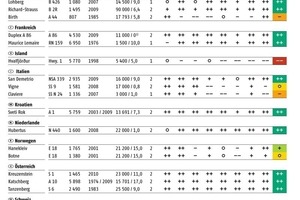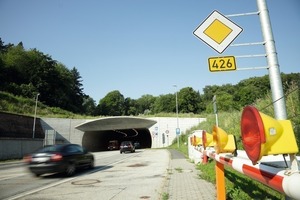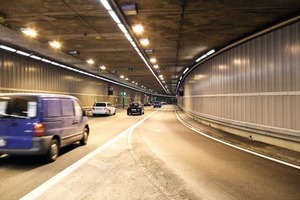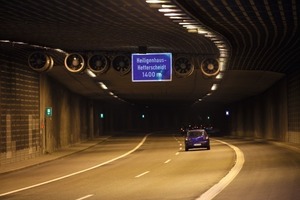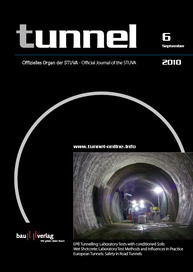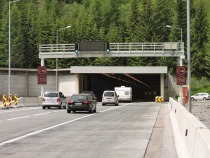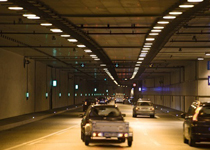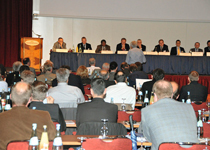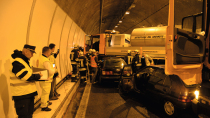Safety in Road Tunnels
Tunnels throughout Europe are tested each year within the scope of the ADAC Tunnel Test. As a result a data bank has been created containing details on safety in numerous tunnels in Europe. The results of this year’s test were announced recently and are oare presented in the following report.
The ADAC and its 15 partner clubs in 14 European countries undertake tunnel tests within the scope of the EuroTAP (European Tunnel Assessment Programme) [1]. Currently there is more building forging ahead in European tunnels than ever before in order to ensure that they comply with the EU guideline [2]. In 2010, the 10th year that saw tunnel test carried out, 26 European tunnels were scrutinised [3, 4]. These included four in Spain, three each in Germany, Italian, Austria and Switzerland, two each in France and Norway as well as one in Belgium, Croatia, the Nether-lands, Slovenia, the Czech Republic and – for the first time – Iceland. The criteria for testing the chosen tunnels related to their length, location on the trans-European road network and significance for travellers.
As in previous years the ADAC commissioned the Deutsche Montan Technologie GmbH (DMT) with undertaking the trst. This year between April 12 and May 20 the tunnels were inspected on the spot in collaboration with the responsible national automobile associations, safety aspects clarified during talks with the operators and corresponding documents scrutinised. Operators were supplied in advance with a list of data pertaining to the most important technical parameters; the details were once again checked at source.
Assessment Criteria
A checklist drawn up by the ADAC and the DMT serves as the basis for evaluation. It also relates to the codes of practice for road tunnels in Germany [5], France, the United Kingdom, Austria and Switzerland [6] as well as EU guidelines per-taining to minimum demands for safety in tunnels on the
trans-European highway network. The checklist is revised annually and split up into eight categories: tunnel system (weighting 14 %). Lighting and energy supply (7 %), traffic and traffic monitoring (17 %), communication such as radio, loudspeakers, and emergency call facilities (11 %), evacuation and rescue routes (14 %), fire protection (18 %), ventilation (11 %) and emergency management (8 %).
Each criterion is assed and receives a certain number of points. The total sum provides the safety potential of a tunnel. It describes all structural and organisational measures, which are intended to avoid emergencies or at least restrict them. The result is compared with the risk potential for motorists. Towards this end the following aspects arte taken into account: tunnel length (1 to 6 points), traffic frequency in the case of one-way and two-way traffic (1 to 10 points), the proportion of lorries (max. 8 points), transportation of hazardous goods (max. 5 points), volume of traffic (vehicles/day/lane; max. 5 points), greatest longitudinal incline of the tunnel (max. 3 points) and additional dangers (crossing within the tunnel: max. 3 points).
The points that are awarded are added up to provide the following risk assessment: very low (2 to 9 points), low (10 to 14 points), average (15 to 21 points), higg (22 to 28 points) and very high (29 or more points).
The safety and risk potentials for a tunnel are added together to arrive at the overall assessment for a tunnel with certain safety measures depending on the existing risk parameters. In this way it is possible to compare tunnels with one another. The ratings very good, good, adequate, critical and sub-standard are applied (Table 1); in Switzerland the last ratings read insufficient and critical.
If a tunnel is assessed overall positively (very good, good or adequate) all eight safety potential categories have to be evaluated positively if possible. There must be no sub-standard rating. Otherwise the so-called k.o. system is applied so that the total rating cannot exceed adequate. This applies especially to evacuation and resuce routes as well as ventilation.
2010 Tunnel Test
The 26 tunnels tested this year possess a total length of 66.8 km: six (23 %) have one tunnel bore and 20 (77 %) have two totalling 24 (35 %) and 43 km (65 %) respectively. With the exception of three all tunnels which began operation after 2000 possess two bores (Table 1). The individual tunnel length ranges from 800 to 6,950 m; on average the tunnel length amounts to 2.6 km.
All investigated tunnels were used by a total of 54,700 pas-sages daily (max. 90,000 in one tunnel) with an average of 9.5 % (max. 41 %) accounted for by lorries. Generally speaking the incidence of accidents rises with increasing traffic volumes and tunnel length.
Test Results
The 26 tunnels that were tested generally resulted on positive ratings. No less than 16 tunnels were awarded very good, 4 good and 2 adequate – accounting for 85 % of the tunnels. Three tunnels were awarded the rating critical and only one was assessed as sub-standard. As a consequence this tunnel test wound up with one of the best results in its 12-year history [7–17].
The newly opened Duplex on the A86 near Paris came out on top – with two traffic zones located one on top of the other (double decks) with traffic travelling in the one direction on the lower deck and in the other on the upper one. This accounts for the low height of the traffic zones so that lorries and buses are precluded from passing through the tunnel. Modern technology, such as a stationary water mist extinguishing system assure high safety.
The 5,400 m long Hvalfjördur Tunnel on the Highway No. 1 near Akranes on Iceland, which came out bottom in the test is a quite different proposition. This 12 year old tunnel passing under the Walfjord is the meast comptabiel with European safety standards and really requires redevelopment.
[<cTracking:-5>] The 1,080 m long [<cTracking:>] [<cTracking:-5>] Lohberg Tunnel [<cTracking:><cTracking:-5>] (Fig. 1) near Darmstadt and the 1,495 m long [<cTracking:>] [<cTracking:-5>] Richard Strauss Tunnel [<cTracking:><cTracking:-5>] (Fig. 2) in Munich, both of which recently became operational, underline how contemporary tunnels can look. They are furnished with everything devised to make tunnels safe and rated very good. The 807 m long [<cTracking:>] [<cTracking:-5>] Birth Tunnel [<cTracking:><cTracking:-5>] (Fig. 3) on the A144 near Velbert is a different kettle of fish: the test result was revised from sufficient to critical on account of sub-standard ratings in the categories traffic, traffic monitoring and communication (k.o. principle). Thus redevelopment of the over 25 year old tunnel is foreseen within the scope of the federal government’s retrofitting programme for 2014. [<cTracking:>]
The three motorway tunnels tested in Switzerland also came up with positive results: the 1,440 m long Murgwald Tunnel (1987) and the 1,763 m ong Witi Tunnel (2002) wqith a very good rating with the 3,960 m long Mont Terri Tunnel (1998) assessed as good – given 12,00 to 27,600 vehicles passing through on a daily basis with 5 to 10 % of this total accounted for by lorries. They only possess traffic lights at the portals for closing the tunnels and no loudspeakers in the tunnels whilst the Witi has neither breakdown bays nor hard shoulders. By 2015 it is intended to modernise the control technology, fire alarm systems and above all the ventilation system (jet fans,
visibility and flow measure-ment technology, concentrated smoke gas removal; Mont Terri: overpressure ventilation in the evacuation tunnel) as well as the emergency power supply.
Spain was represented with four tunnels in the test. In this connection the three recently opened tunnels obtained good results: the 4,558 m long Brancons Tunnel and the 2,170 m long Cantalobos Tunnel were awarded very good and the 800 m long Valdfepastores good. How-ever the 1,007 m long Pedra do Conto Tunnel (1999) was described as critical. There is no continuous traffic information service and no continuous tunnel radio for emergency services quite apart from a lack of emergency exits.
Three recently opened tunnels were tested in Italy. In this connection the 2,935 m long San Demetrio Tunnel was rated very good, the 1,581 m long Vigne Tunnel adequate and the 1,336 m long Claviere Tunnel critical. The traffic information service was not continuously available; there were no loudspeakers and the evacuation routes in the tunnel possessed no emergency lights. In the case of Claviere there were no additional emergency exits.
Very good following Refurbishing
Three of the tunnels were included in the test on several previous occasions and this time around were rated very good following refurbishing:
The 5,898 m long Katschberg Tunnel (1974) on the A10 near St. Michael/Austria (1999 critical and 2002 adequate) received a second bore, now possesses sufficient emergency exits for the redeveloped initial bore (112 mill. euros).
The 2,490 m long Tanzenberg Tunnel (1983) on the S6 near Bruck an der Mur/Austria (2001 adequate) has since been redeveloped and provided with the latest technical standards as well as
The 6,950 m long Maurice Lemaire Tunnel (1978) near Saint Dié des Vosges/France (2002 adequate) now possess sufficient emergency exits to a newly constructed parallel evacuation tunnel, continuous traffic iuformation service, video monitoring and an automatic fire alarm system.
The most frequent Faults
In the case of more than half of the tunnels the period use for the breathing protection equipment for the fire service amounting to less than an hour was insufficient. There were no loudspeakers in the case of more than 1/3 and no hydrants existed at the portals in more than 1/4 of the tunnels: 1/4 had no barriers to close the tunnel and/or information panels in front of the portals. In every 4th tunnel dark walls catered for a subdued atmosphere or communication via emergency call was insufficient or the evacuation routes were not properly marked. Every fifth tunnel lacked proper lighting and a comprehensible continuous traffic information service, there were no emergency drill held at regular intervals or smoke could not be prevented from entering the neighbouring bore in the event of a fire. In the case of four tunnels the distance between emergency call facilities was excessive and there was no extinguishin water supply available in the tunnel.
Outlook
The pleasing trend emerging from this year’s test shows the great efforts on the part of the tunnel operators to substantially improve the safety standards of their facilities. European tunnels are becoming ever safer. New and redeveloped tunnels practically always achieve good ratings; old tunnels or those that still require to be modernised receive poor marks. In other words extensive efforts have to be undertaken to ensure that motorists can feel safe all over Europe.
As a consequence the refurbishing of tunnels by 2014 as called for in the EU guideline must be consistently applied. This also applies to the tunnels in Germany: by then some 810 mill. euros are to be invested in 232 tunnels on federal highways for modernisation and safety purposes. Refurbishing programmes can be successful as is displayed by three tunnels in Austria and France that have been tested several times: following their modernisation all have now been classified as “very good”.
However the outcome of this tunnel test also shows just how much the tunnel operators have to do. They are provided with recommendations and motorists given tips on how to conduct themselves when driving through tunnels especially if incidents should occur (tailbacks, breakdowns, accidents and fire incidents).

